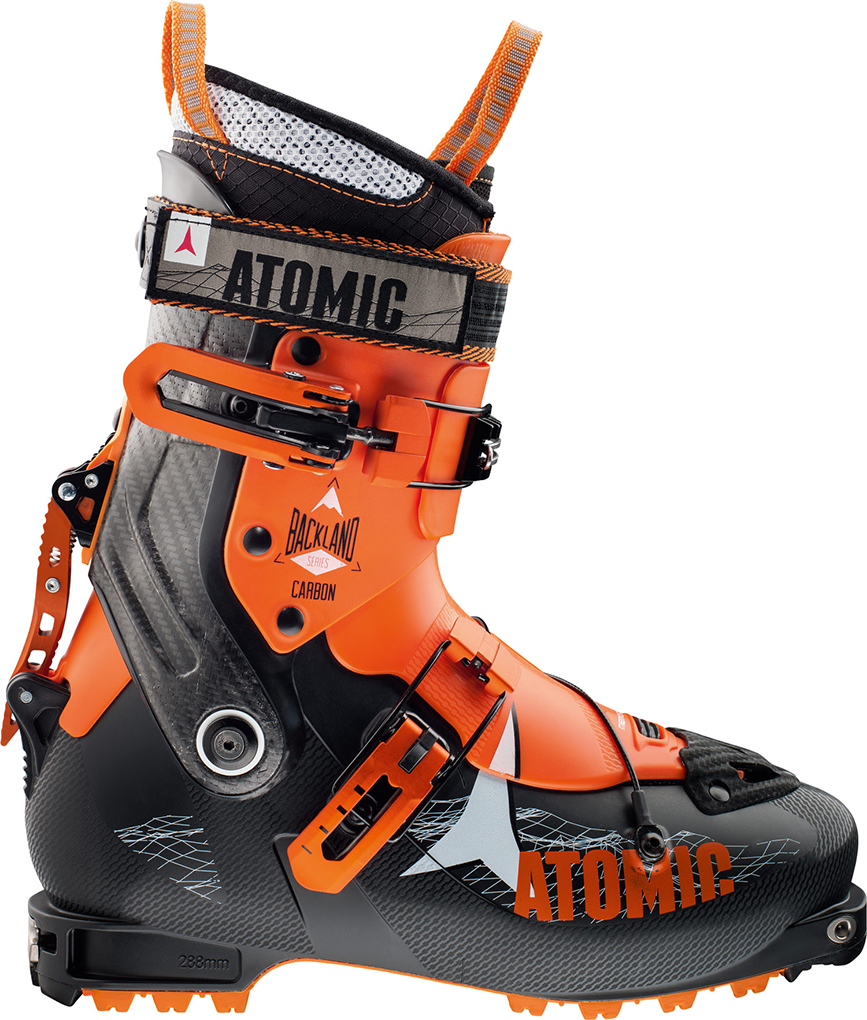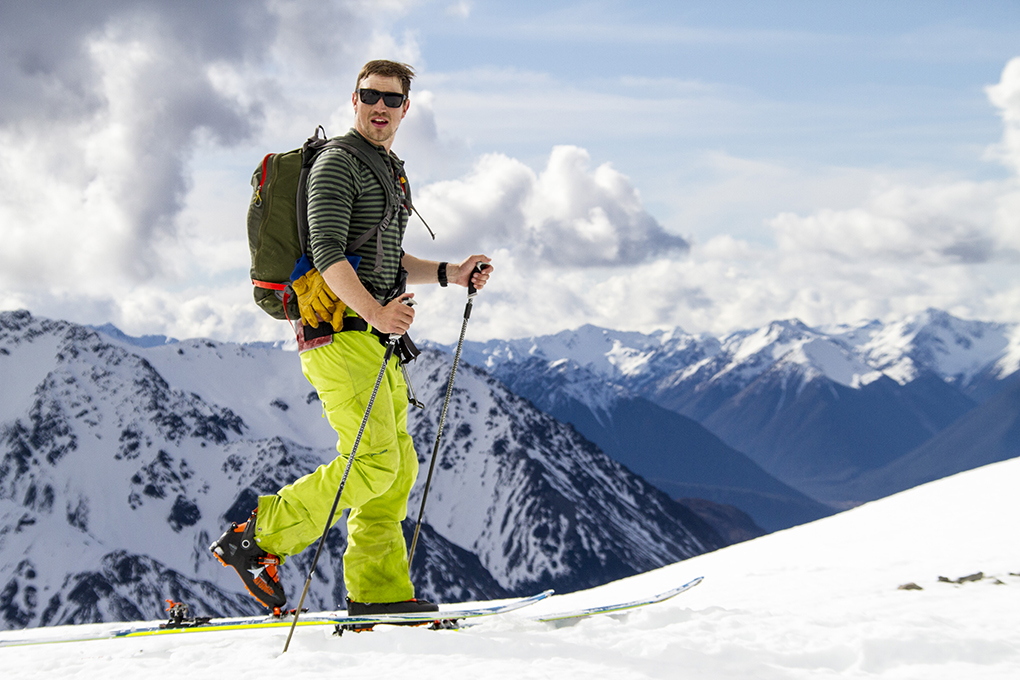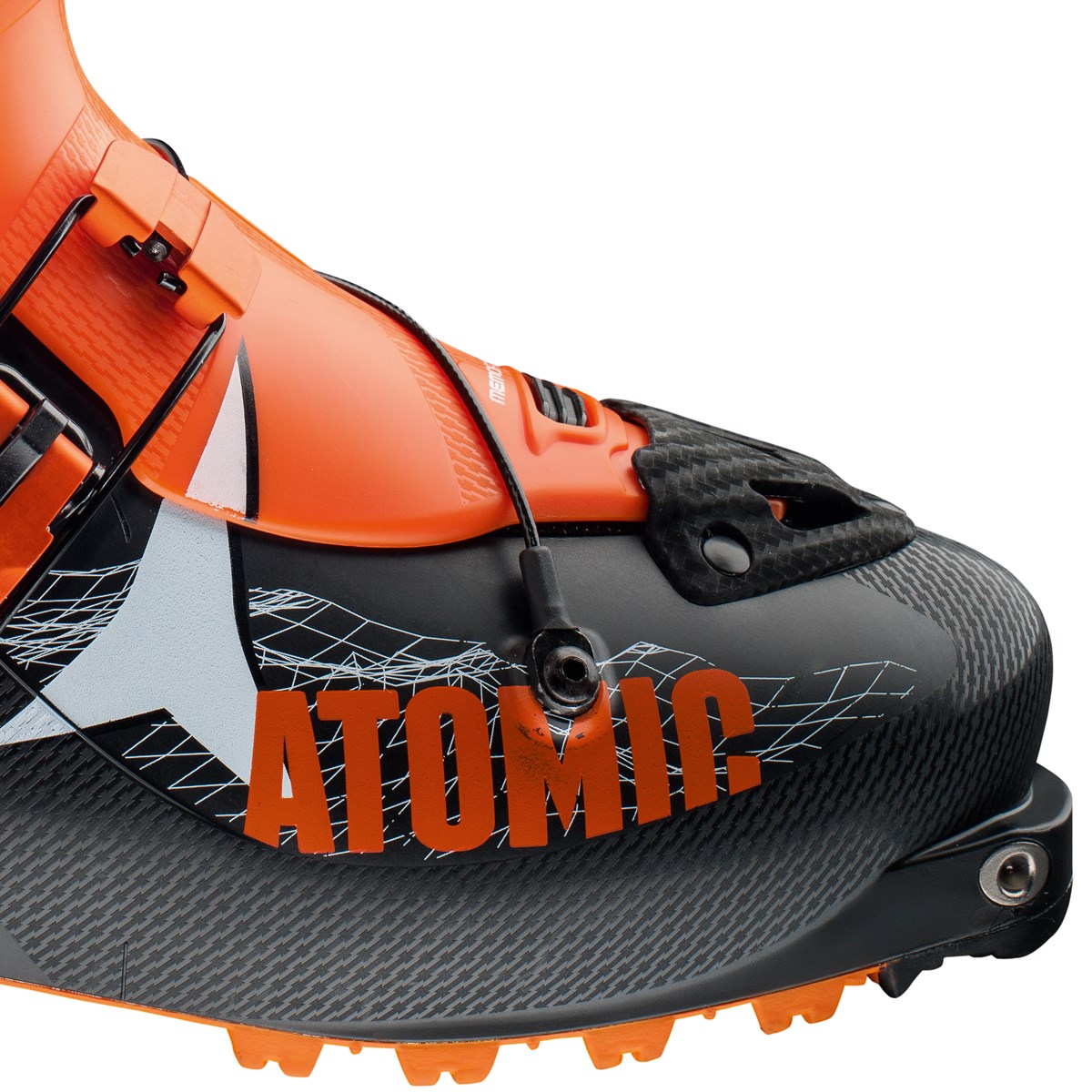
2018-2019 Atomic Backland Carbon AT Boot
Available Sizes: 24.5 – 30.5
Size Tested: 27.5
Stated BSL (27.5): 298 mm
Stated Last: 98 mm
Stated Range of Motion: 74°
Stated Weight (27.5) : 1161 g per boot
Blister’s Measured Weight
• Shells, no liners: 907 & 915 grams
• Liners: 260 & 255 grams
• Shells + Liners: 1167 & 1170 grams
MSRP: $750
Test Locations: Craigieburn Valley Ski Area, Porters Ski Field and backcountry
Ski / Bindings Used: G3 Ion / Salomon MTN Explore 95
Days Tested: 4
[Note: Our review was conducted on the 15/16 Backland Carbon, which was not changed for 17/18 or 18/19, apart from graphics.]
Intro
The Atomic Backland boot series are intended to be lightweight, high-performance, dedicated ski touring boots, and are a significant departure from anything the company has done before.
Atomic describes the new Backland boot line as, ”100% built for touring, so they’re super light and come with incredible mobility to make climbing feel totally natural. Plus, unlike other touring gear, they’re packed with Atomic technology for powerful skiing and awesome comfort.”

There are four new boots in the Backland lineup. We tested the Backland Carbon, which is the stiffest-flexing boot in the series.
The Backland Carbon Light ($899) uses a similar shell construction, but shaves off a bit of weight compared to the Backland Carbon. The Carbon Light includes an Ultralon liner (the same foam used in Intuition brand liners), and two sets of tongues of varying stiffness, and costs about $150 more than the Backland Carbon ($749).
For around $100 less than the Backland Carbon, the Backland ($649) and Backland Womens ($649) have a Grilamid cuff rather than a carbon fiber cuff.
Construction / Design:
Shell and Buckles
The Backland Carbon uses a basic construction that looks a lot like the Dynafit TLT6 and the Vulcan Mercury series which remains a significant departure from most touring boots on the market. Put simply, these boots are all constructed with a lightweight, relatively low-volume Grilamid lower shell that is connected via pivots to a carbon or fiberglass reinforced upper cuff (in the case of our boot, the upper cuff is carbon).
For increased downhill and uphill performance, they all feature a removable tongue that slides in under the buckles, and those buckles are largely made of lightweight cables connected to camming buckles.
Atomic has put together a nice 90-second video that clearly shows all of this:
The Backland differs slightly from the TLT6, in that it has a wrap-around lower buckle that provides a larger pressure distribution (probably more equivalent to 1.5 or 2 lower buckles), but is a bit more finicky to work with, because it’s longer and requires lacing over a plastic hook.
The upper buckle of the Backland is a simple micro and macro adjustable buckle. In this way, it differs significantly from the “Ultralock” Dynafit boots mentioned above, because the Backland Carbon’s buckle is completely independent of the ski / walk lock system, while the Dynafit system locks the upper cuff and buckle in one motion. I’ll touch on this more below.
Another unusual feature of the Backland Carbon is the swath of water-resistant textile that creates a nice extra barrier to snow and water even when tongue is not installed. This piece of material does, however, make it a little more difficult to get the liners in and out of the boot.

Removable Tongue
Having now owned five pairs of ski boots that have removable-tongues (two TLT5s; one TLT6s; one Vulcan; and now these) I have a lot of experience with removable-tongue touring boots. I’ve even experimented with modifying a pair of Full-Tilt tongues to fit in my TLT5s, and have helped create a set of vacuum-bagged carbon reinforced tongues for my TLT6s. As a result, I’ve become quite comfortable placing, removing, and managing the tongues.
Given my experience, I have to say that the Backland Carbon tongues are far more difficult to use than any of the Dynafit boots referenced above. This is based primarily on how hard they are to insert and, even moreso, remove.
The tab of plastic on the lower shell that is designed to hold the tongue in place seems to be much bigger than it needs to be, and makes it very difficult to pull the tongue off. I’ve tried all kinds of strategies, and finally settled on completely unclipping all of the buckles and pulling really hard straight up. The first time I did this, I had to pull so hard I thought I might break something, and it hasn’t gotten much easier over a few weeks of using them. There may be some trick that I’m not aware of, but it’s enough of an issue that it discourages me from removing them for short hikes, where I wouldn’t have thought twice about it with the Dynafit removable tongue models. I may ultimately take a dremel to that tab to mellow it out a little bit; it seems unnecessarily bulky and obtrusive.
NEXT: Pivot, Walk / Ski Mechanism, Etc.

It’s annoying how you said throughout the article how great they ski, but at the end, finally, “the downhill performance isn’t close to salomon’s boot.
Hi Rod, Thanks for reading and for your reply. We tried to make it clear throughout the review – and especially in the section where we mentioned the MTN Lab – that this is a very lightweight boot that really shouldn’t be compared with boots like the MTN Lab because the design, construction, and intended use of the Backland Carbon is different. The Backland Carbon skis very well for a 1200 gram boot and should be enough boot for many skiers looking for a very light, touring-friendly boot that can still hold up to hard skiing. It is NOT a freeride oriented boot (the MTN Lab IS a freeride oriented boot) and should not really be compared to one.
Nice review. I’ve had these for a week or so now and found that removing the tongue is best achieved pulling up and inward – made quite a difference in my experience.
Curious to hear your experience adding a booster strap, I have considered the same. In the mean time i’ve had luck using the strap above the plastic cuff btwn the cuff and the liner when skiing; it gave the boot the feeling of another inch or so of height. Cheers
Thanks TN! Will be sure to update if I get a booster strap on them.
If you pull straight up on the tongue, it won’t come out easily. You need to twist it and then it pops out just fine. Also when taking the tongue out/in, don’t completely undo the shell cable- keep it attached to the buckle, but undo it from the inside tab. I’ve found that works better than completely undoing everything.
I can confirm. I have been using these boots the last couple weeks. Very good boot on the uphill. Very adequate on the downhill relative to the boot’s weight. Comfortable too!
Thanks Charlie!
I’ve had these boots since January. I use them coupled with a pair of Cochises for resorts, sidecountry, road laps, and other short tours. I’ve used them perhaps 15 days?
You get used to the tongue (or perhaps it wears down). When I first got them, I felt the same way you did. By now, its no more difficult than the TLT5Ps that I used to own. In the mean time, attatch a small bit of perlon cord to the tongue to pull on – way easier.
As an aside, I’ve found that the lower buckle cord hooks are perfectly designed for adding and removing the tongue. I can leave the buckle on the same notch, but simply change which cord hook you use.
You mention not being able to use Intuition liners due to the low volume. You REALLY need to mold the shell. It’s impressive how well it works. I can’t bearably tour for long in TLT5s, so they never got used how they should have, even after huge amounts of shellwork (hours of direct labor). One heatmold and I’m good in the Backlands. I can even fit a MV ProTour liner in them (impossible in my TLT5s – had to use the stock ultrathin liner). I guarantee you can use your preferred liner after heat molding the shell.
Once heat molding the shell and using your preferred liner, it will solve the cuff height issue you noticed (and that I noticed). The boot skis night and day better with my ProTour liner, almost entirely because of the significantly taller cuff height.
As TN mentions, apply the powerstrap to the top of the liner, not the tongue. This engages the full height of your now Intuition liners, and gives you the leverage and support that you’re yearning for.
I have a pretty high volume foot (the Cochises fit me really really well – even the large heel pocket – and was crippled by my TLT5s), but now can fit an Intuition ProTour. I had issues with adding and removing the tongue, but it has worn enough to be super easy now. I had issues with getting the support and leverage I desired due to cuff height, but not after an Intuition liner and proper application of the powerstrap. Basically the major drawbacks you mention have solid solutions. Hope you find the same after more time (and no, I’m not a shill – I paid full retail for my boots).
Finally: “My suspicion is that an increasing number of skiers will realize that boots like the Backland Carbon are a great choice for a large percentage of what many of us do much of the time we’re out ski touring, and that the extra weight of the more freeride-oriented boots will start to make less sense as this class of lightweight touring boots becomes more refined and more affordable.”
I whole heartedly agree. For regular touring and ski objectives, this class of boot really is the right choice, while my Cochise fills the crossover role when I feel like getting rad or when I’m at the resort. Great combination. I’ve skied heavy 115mm skis with the Backland with no qualms. Killer boot when I’m doing any type of normal touring or ski objectives – including skiing fast in funky snow (even stomped a nice 20ish cliff with em no problems). I only reach for my Cochises when huge cliffs or resorts are on the agenda.
Great info, Brian. Thanks. And thanks to everyone who has chimed in. Very useful comments.
Right on Brian! Super helpful. We have the best readers!
I’ll be sure to update here after I get a chance to mold the shell and try on the other liners. I’m excited.
Hello Brian!
Сould you compare the fit and size Backland and Cochise?
I have Cochise Pro light in 27.5 – it fit great for me with molded Palau liners. As I read in the Blister’s review and could confirm myself – Cochise have a lot of volume in shells with small liners. And i couldn’t make right choice – 27.5 or 28.5 Atomic Backland?
Thanks a lot!
It would be great to add lasportiva spitfire into reviews of 1200 ski touring boots with solid downhill performance. Somehow they get notoriously omitted from reviews of available options.
I had a comment typed out on the bus, accidentally deleted it, went to work, came back, saw Brain’s, and now I don’t need to post it. 3 tours in them so far and I wholeheartedly agree with the above. Loving them – they go up like a dream and have plenty on the down- and that’s even without Intuition Pro Tour’s yet…
+1 on the spitfire 2.0 comment. Seem like a very competitive boot for the light/fast touring or citizen skimo racer. I’m interest in any experience anyone has on them, particularly when it comes to how they fit!
Jeremy and Mykhallo, Thanks for the comments and suggestion! I’d be happy to check out the Spitfire 2.0 and will be sure to get up a review if we end up with a pair.
Skinning tip: try dragging your skis rather than lifting them like you are walking.
Ha ha! I’ve been waiting for someone to mention that. Couldn’t agree more Jim. Was trying to make boots visible for a photo. Bad form indeed!
Backland users: Is the stock liner so thin that it poses a concern for cold weather (0ºF) tours? If so, it sounds like fitting the shell for an Intuition may be a viable solution.
Hey Gabe! I haven’t had them in cold temps yet and don’t tend to get cold feet but I’ve wondered the same thing. I think there may be multiple advantages to using an intuition liner in these. Keep in mind that the Carbon Light version does include an ultralon foam liner but we haven’t had our hands on that boot yet.
I had the Backlands out touring yesterday and it was prob around -5 in the morning – no problems with cold feet, and I tend to get pretty cold toes in Alpine boots. I’ve also kept the tongues in for my past 2 long tours as an experiment and they still go uphill very well indeed. I think in the future I’ll probably only bother taking the tongues out if I know we have a long approach to a hut and I’m carrying significant weight, or maybe on traverse days with more flats / ups than downs. For general backcountry skiing and ridge laps, I think the tongues will just stay in – for me it’s not that they’re that hard to deal with, it’s just another thing to worry about and as far as I’m concerned the boots are still fantastic on the up-track with them in.
I completely agree with the review, in each part.
Great boots in terms of comfort and impressive skiing for their weight.
However, I am very disappointed with their quality, which I found poor compared to Dynafit or Scarpa.
The screws on the buckles were not tide. The liners look already old after 2 months of use, and the powerstrap is falling apart.
Customercare does not seem to be very supportive either…
Great post, thank you!
I was looking for a comment on how low this boot feels. then I read this:
“I’m going to take them to Powderhound Ski Shop in Girdwood next week to see if we can figure out a way to make a taller, more supportive liner work in them. I’ll also be adding some sort of elasticized booster strap. If these things make a significant difference, I’ll update this review.”
Did you have any experience on this? I also feel the boot very low, creating strain on my legs that I’m sure would disappear if the power strap made the pressure a little higher on the leg.
Thanks for any comment you can provide!
years past since your review BUT i would like to mention, that it’s quite easy to remove the tongue. just open the straps,… and put it sideways – like atomic discribes it in their manual. it takes me only seconds and no power to get it out or even in. i have no comparison to dynafits system but for me it’s no problem to get it in our out.
Can the lean angle be changed on the Carbons? The forward lean angle prevents me from straightening my leg while climbing. It’s uncomfortable and tiring. I assume this must be done by heating the shell and reforming the boot.
What bindings do you match with the boots ?
Last season I was using fritschi but on some point it made a kind of push hole when my leg slip down…
Due to the problem I don’t recomend to combine to combine this two.
Hello,
I would like to ask to compare atomic backland carbon with dynafit Neo PX ( winter guide CP). Which is better.
Thanks Peter